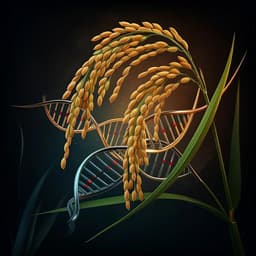
Agriculture
Genomic variants affecting homoeologous gene expression dosage contribute to agronomic trait variation in allopolyploid wheat
F. He, W. Wang, et al.
This groundbreaking study reveals how wheat accessions utilize expression quantitative trait loci (eQTL) to influence homoeolog expression dosage, shedding light on the genomic variants that shape agronomic traits. Conducted by a diverse team of experts including Fei He, Wei Wang, and Katherine W. Jordan, it emphasizes the critical role of genetic factors in enhancing crop yield in polyploid wheat.
Playback language: English
Introduction
Whole-genome duplications (WGD) offer short-term evolutionary advantages and played a crucial role in crop evolution. Wheat, having experienced multiple WGD events, exhibits broader geographic distribution than its diploid relatives, suggesting WGD's importance for environmental adaptation. The success of polyploid crops is attributed to adaptive genetic diversity from ancestral species or generated de novo after WGD. Polyploid genomes' redundant nature allows novel variant accumulation without fitness penalties, explaining their mutational robustness.
Regulatory variants influencing gene expression levels are key drivers of adaptive evolution and complex trait variation. WGD significantly expands the potential for trans-interactions among regulatory variants controlling the expression of redundant homoeologous genes, resulting in altered expression patterns in polyploids compared to their diploid ancestors. The genomic distribution of these trans-acting variants and their role in homoeologous gene regulation in polyploid crops remain unclear, despite transcriptomic studies highlighting the importance of trans-regulatory evolution in domestication.
The unique aspect of WGD regulation involves homoeologous regulatory proteins interacting with duplicated genomes' regulatory elements, creating complex regulatory networks. Regulatory variants linked to one homoeolog can alter its expression and dosage relative to others. Previous genetic mapping in allopolyploid wheat identified genes where regulatory variants associated with adaptive and domestication traits also changed homoeolog expression levels. However, the overall impact of genomic variants on population-scale homoeolog expression variation and their role in shaping adaptive traits remains poorly understood. This study addresses this gap by performing eQTL analysis using diverse allohexaploid wheat accessions.
Literature Review
The literature extensively documents the significance of whole-genome duplications (WGD) in plant evolution and the adaptive advantages they confer, particularly in the context of polyploid crops such as wheat. Studies have highlighted the role of WGD in expanding genetic diversity and promoting phenotypic plasticity, allowing for adaptation to diverse environments. Previous research has also emphasized the importance of regulatory variants in shaping gene expression levels and contributing to complex trait variation. The impact of WGD on regulatory networks, particularly the interplay between cis- and trans-acting regulatory elements, has been a subject of ongoing investigation. While some studies have explored the impact of specific regulatory variants on homoeolog expression in polyploid crops, a comprehensive understanding of the population-scale variation in homoeolog expression dosage and its contribution to agronomic traits remains elusive. This research draws upon existing knowledge of WGD, gene expression regulation, and polyploid genetics to investigate the specific role of genomic variants in influencing homoeolog expression and phenotypic diversity in wheat.
Methodology
This study employed RNA-seq data from 198 diverse allohexaploid wheat accessions (AABBDD) to perform expression quantitative trait loci (eQTL) analysis. The accessions were selected to represent broad geographic and genetic diversity. RNA-seq libraries were prepared using the TruSeq RNA Sample Prep Kit (Illumina), yielding an average of 65.7 million paired-end reads per sample. Reads were mapped to the reference genome RefSeq v.1.0 using HISAT2, with 81% of reads uniquely mapped. Expression levels (TPM) were estimated for high-confidence genes. The study also incorporated previously generated RNA-seq data from 90 wheat lines' spikes.
Homoeologous gene expression variation was analyzed, comparing triplets, two-copy genes, and singletons. Spearman Correlation Coefficient (SCC) was used to measure relative homoeolog expression. The study investigated whether downregulation of one homoeolog was compensated by increased expression of others. Genetic variance partitioning was performed to assess the contribution of SNPs from the A, B, and D genomes to homoeolog expression variance. This approach distinguished between cis-genomic SNPs (within the same genome as the gene) and trans-genomic SNPs (in other genomes). The analysis focused on the top 10,000 most highly expressed genes.
The study also mapped cis- and trans-acting variants (eQTL) associated with gene expression variation among 191 wheat lines. A conservative criterion defined trans-eQTL as those located on different chromosomes or genomes from the target gene, and cis-eQTL as those within ±1 Mb. eQTL enrichment was evaluated within specific genomic regions, including coding sequences (analyzed using SNPeffect), regulatory regions defined by epigenetic marks and open chromatin, and regions of closed chromatin. The study also assessed the relationship between eQTL-target gene pairs and 3D chromatin contacts identified by Hi-C data. The correlation between the minor allele frequency and the effect size of cis-eQTL was compared for homoeologs and singletons.
The study further examined the genetic architecture of homoeologous gene expression regulation, analyzing trans-eQTL distribution and their target genes. It explored the co-localization of trans-eQTL and target genes in syntenic regions of homoeologous chromosomes and the correlation between the expression levels of homoeologs and the proportion of shared eQTL. Joint eQTL and GWAS analyses were conducted using summary-level data from the current study and the 1000 wheat exome project. SMR analysis was used to identify candidate genes whose expression covaries with phenotypes, distinguishing pleiotropy from linkage using the HEIDI method. An eQTL-based gene co-expression network was constructed to connect the SMR candidate genes and biological pathways.
Finally, the study investigated the association between productivity traits and the number of homoeologous alleles resulting in biased expression. Ridge regression modeling was used to predict productivity traits based on the expression of negatively correlated homoeologs, comparing the results to those obtained using random gene sets. The association between the negatively correlated homoeologs and phenotypes was also validated using a panel of lines from the 1000 wheat exomes project.
Key Findings
This study reveals that genomic variants significantly impact homoeologous gene expression dosage in polyploid wheat, thereby influencing agronomic traits. Key findings include:
1. **Cis-acting variants primarily determine homoeologous gene expression dosage**: While trans-acting effects play a major role in overall expression regulation, the relative expression of homoeologous genes within a genome is largely influenced by cis-acting variants. These cis-variants appear to be under selective pressure.
2. **Biased homoeolog expression is linked to yield-related traits**: The frequency and expression levels of homoeologous gene alleles displaying significant expression dosage bias are strong predictors of variation in yield-related traits. This suggests that breeding efforts for increased productivity have inadvertently influenced the frequency and expression of these alleles.
3. **Relative contribution of cis- and trans-eQTL is influenced by selection and demography**: The relative contribution of cis- and trans-acting eQTL to homoeologous gene expression shows a complex interplay with selection and demographic events such as polyploidization and gene flow. The less diverse D genome exhibited a more similar contribution from cis- and trans-genomic variants, unlike the more diverse A and B genomes where cis-genomic variants explained a larger portion of the variance.
4. **eQTL enrichment in active chromatin regions**: Significant enrichment of eQTLs is found within regions of active chromatin, indicating the detection of SNPs that play vital regulatory roles in the wheat genome.
5. **Joint eQTL and GWAS analyses identify candidate genes**: Integrating eQTL and GWAS data identified many candidate genes linked with variation in yield components and developmental traits. The *TaSPL14* gene was found to be associated with spike compactness, grain length, and harvest weight, aligning with the effects observed in *TaSPL14*-knockout mutants. The *TaElf3* gene was also identified in this analysis.
6. **Negative correlation between homoeolog expression and high LD**: Several pairs of homoeologous genes exhibited negative correlations in their expression levels. These negatively correlated homoeologs showed elevated inter-chromosomal linkage disequilibrium (LD) between associated SNPs, suggesting non-random allelic combinations potentially driven by selection.
7. **Homoeolog expression bias is associated with productivity traits**: The number of low-expressing alleles from negatively correlated homoeologs shows significant correlations with multiple productivity traits, such as grain length, width, and weight, and heading date, spikelet number, spike length, and plant height. This suggests that selection pressures in breeding have favored specific allelic combinations.
Discussion
This study's findings address the research question by demonstrating a significant connection between genomic variants impacting homoeologous gene expression dosage and phenotypic variation in yield-related traits in wheat. The results highlight the importance of considering the complex interplay between cis- and trans-acting regulatory elements in shaping adaptive traits in polyploid crops. The strong association between biased homoeolog expression and productivity traits suggests potential targets for crop improvement strategies. The study underscores the utility of integrating eQTL and GWAS data for identifying causal genes and understanding the genetic basis of complex traits. The identified candidate genes and regulatory networks provide valuable insights into the genetic mechanisms underlying yield variation, paving the way for more targeted breeding and genome-editing approaches.
This work advances the field by providing a comprehensive analysis of the genetic architecture underlying homoeolog expression regulation in wheat. The findings are broadly relevant to the understanding of polyploid evolution and have practical implications for crop improvement efforts. The integration of eQTL and GWAS data provides a powerful approach for dissecting the genetic basis of complex traits in polyploid species.
Conclusion
This research demonstrates a strong association between genomic variants affecting homoeologous gene expression dosage and agronomic trait variation in wheat. Cis-acting variants predominantly control homoeolog expression dosage, and biased expression is linked to yield-related traits, likely influenced by breeding selection. Integrating eQTL and GWAS data identified candidate genes, including *TaSPL14* and *TaElf3*, associated with productivity. Future research should focus on functional validation of candidate genes and further investigation of the regulatory mechanisms underlying homoeolog expression bias to optimize wheat breeding strategies.
Limitations
The study's reliance on association mapping limits the ability to definitively establish causality between identified variants and phenotypic traits. Environmental factors not fully accounted for in the analysis might influence gene expression and trait variation. The use of a single reference genome for read mapping might introduce biases due to potential structural variations or allelic differences among accessions. Further functional validation of candidate genes would enhance the study's conclusions.
Related Publications
Explore these studies to deepen your understanding of the subject.







